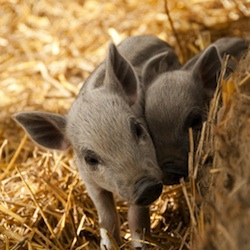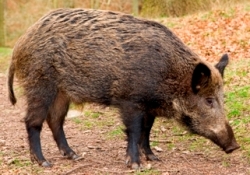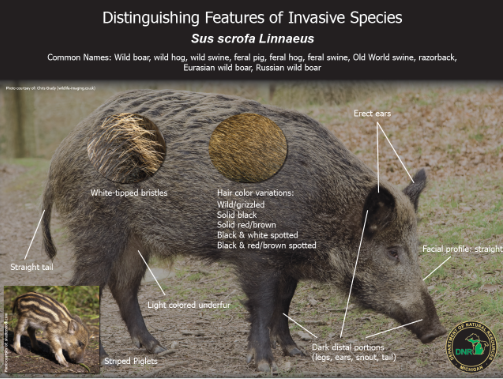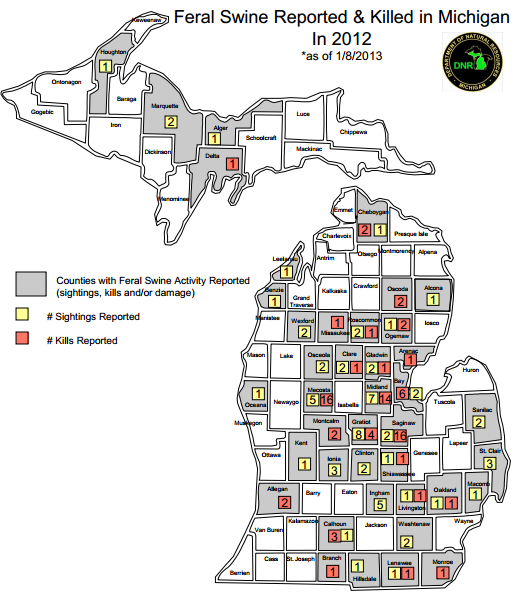 Mangalitsa piglets, a Russian boar hybrid Mangalitsa piglets, a Russian boar hybrid
|
In a victory for Michigan’s heritage breed hog farmers, Marquette County Circuit Court Judge Thomas L. Solka has ruled that both the swine Invasive Species Order (ISO) and the Declaratory Ruling (DR) issued by the Michigan Department of Natural Resources (DNR) are unconstitutional. In his March 21 decision, Judge Solka granted injunctions preventing DNR from enforcing the ISO against plaintiffs, game preserve operator Greg Johnson and hog farmer Roger Turunen; but the judge also stayed those injunctions pending any appeal of his ruling by DNR.
Johnson owns and operates Bear Mountain LLC, a Marquette County hunting preserve that is populated with Russian boar. Turunen owns a farm in Barraga where he raises Russian boar mostly for sale to game ranches in Michigan. Johnson has been purchasing swine from Turunen since 2010.
The ISO prohibits the possession of various swine, including “…feral swine…Eurasian wild boar [and]…Russian wild boar.” In December 2011, DNR issued the DR in which the department said it would distinguish illegal swine from legal swine based on the animal’s physical characteristics (phenotype) rather than basing its decision on whether the pigs were in the wild (i.e., feral) or under human husbandry. According to the DR, a pig having just one of the eight physical characteristics would be prohibited; a pig with a straight tail could be prohibited but so could a pig with a curly tail. Any domestically raised pig could be prohibited under the broad and vague standards of the DR. The ISO stated it “does not and is not intended to affect sus domestica involved in domestic hog production” but it was unclear what sus domestica meant.
In his decision, Judge Solka held that the ISO and the DR constitute an “unreasonable and arbitrary classification” [p. 13] of pigs under the control of these plaintiffs as illegal, invasive species. The ISO and DR violate the ‘equal protection’ and ‘due process’ clauses of both the U.S. and Michigan Constitutions in denying equal protection of the laws without a rational basis for these plaintiffs and others owning hybrid pigs. The court also concluded that the animals in the possession and under control of Turunen and Johnson meet the exemption set forth in the ISO for sus domestica (i.e., domestic hog production).
 Sus scrofa Linnaeus, per Michigan DNR Sus scrofa Linnaeus, per Michigan DNR |
In the ruling, Judge Solka observed that the ISO “makes it a felony to possess a hybrid or genetic variant of … Eurasian wild boar or Russian wild boar.” In reviewing information from experts on swine breed classifications, Solka acknowledged that the sus domestica (legal swine) and the sus scrofa scrofa (illegal swine) are “both descendants of the Eurasian wild boar and are genetically related.” As such, deciding the legality of pigs by physical characteristics has no rational basis under law.
Judge Solka concluded that the “entire thrust of the ISO and DR is to prohibit and prevent feral and wild swine.” Given that “a feral pig is any free-roaming pig not a particular breed of pig” and a “wild” pig would be one “living in nature without human control or care”, neither Johnson’s nor Turunen’s animals could be considered as feral or wild because their animals are “under the control and care of their owners.”
Johnson and Turunen initially filed lawsuits challenging the constitutionality of the ISO in February 2012; their cases were later consolidated along with separate suits filed by heritage breed hog farmer Mark Baker and pet pig owner Matt Tingstad; Tingstad is no longer a party to the case. Baker received court approval to pursue his case independently of the others in 2013.
On February 26, 2014, Missaukee County Judge Fagerman dismissed Baker’s case when Assistant Attorney for the state Harold Martin told the court that the Russian boar hybrids Baker raises on his farm were in compliance with the ISO. Until early this year, DNR had been seeking a court order fining Baker $700,000 for the same herd being in violation of the swine ISO. Baker’s Russian boar hybrids were clearly illegal but the DNR wanted to avoid a hearing on the merits of the Declaratory Ruling.
DNR could not use the same strategy with Turunen. If the department had determined that his pigs were legal, that would have meant Johnson’s pigs would have been legal as well. DNR’s main purpose in issuing the ISO was to put the private hog hunting preserves out of business. The department earns revenue by selling licenses to hunt hogs on public land; private game preserves like Johnson’s are unwanted competition.
The other big loser as a result of Judge Solka’s decision was the Michigan Pork Producers Association (MPPA) which had invested considerable time and money having the swine ISO become law. Enforcing the ISO and the DR against heritage breed farmers raising their pigs in the outdoors would have meant more market share for the MPPA’s confinement operation members along with greater potential to eventually monopolize the genetics of swine in the longterm.
DNR has until April 21 to appeal Judge Solka’s ruling.
 You can help the Fund by donating to defray the legal expenses involved in important cases like these.
You can help the Fund by donating to defray the legal expenses involved in important cases like these.
The Fund is not an insurance company and cannot guarantee representation on all legal matters; possible representation is just one of the benefits of membership. View other FTCLDF Cases.
Prefer to make a tax-deductible donation? For details,
go to farmtoconsumer.org/PIL
DNR’s DECLARATORY RULING – MICHIGAN SWINE ISO
The Declaratory Ruling was issued in December 2011 in answer to the question of what are “the exact standards that MDNR will be utilizing to determine the hybrid, genetic variants and offspring of prohibited swine.”
Prohibited Species, per Declaratory Ruling:
- Wild boar, wild hog, wild swine, feral pig, feral hog, feral swine, Old world swine, razorback, eurasian wild boar, Russian wild boar Sus scrofa Linnaeus). This subsection does not and is not intended to affect sus domestica involved in domestic hog production.

Print Image or
View Image at www.michigan.gov/documents/dnr/Feral_swine_photo_illustration_381452_7.pdf
Instead of genotyping, DNR will use phenotyping “to identify Sus scrofa and distinguish it from other species. Identification may include use of one or more of the following characteristics:” [underlining added]
- Bristle-tip coloration
- [Distal] “Point” coloration
- Coat coloration
- Underfur
- Juvenile coat pattern
- Skeletal appearance
- Tail structure
- Ear structure
- Other characteristics not currently known
Heritage hog breeders are caught in the cross-hairs; hybrids, genetic variants and offspring will be considered “prohibited swine” if any of the phenotype characteristics are observed. Most notable are the ambiguous characteristics: ear structure (“erect or folded/floppy”–what else is there?) and tail structure (“curly or straight”–again, what else is there?).
The proclaimed impetus for issuing the swine ISO is that there is a problem with feral swine in Michigan; but is it really a problem in Michigan or is it Invasive Hype?
VIDEO INTERVIEW MARK BAKER – ALEX JONES
“Feral Gov Attacks Family Farm” – posted on YouTube by The AlexJonesChannel
Published on Feb 25, 2014
We talk to Mark Baker of Baker’s Green Acres, a family farmer who has been under attack for almost 3 years from factory farms using their political clout to shut down their competition from small family farms that raise a premium product.
In December 2011, the State of Michigan declared heritage pig breeds that had been raised by farmers for decades to be ‘feral’ pigs. The designation was based simply upon physical description, not upon the behavior of the pigs or health issues with the meat. In fact, Mark Baker raises his pigs in a way where they can free range on his farm getting exercise and sunshine just like grass fed beef or free range chickens.
The proclaimed impetus for issuing the swine Invasive Species Order (ISO) is that there is a problem with feral swine in Michigan; but is it really a problem in Michigan or is it Invasive Hype?
Michigan Map: Feral Swine Reported & Killed Sightings in 2012
The Michigan Legislature had already passed a ‘shoot-on-sight’ law in 2010 to address the feral swine issue; judging from the numbers of sightings and kills, there really is no feral swine problem in Michigan as compared to other states like Texas. Michigan has been tracking reports of feral swine sightings and killings since at least 2001.
View the Feral Swine Sighting Report (Updated 8/5/2013) at http://michigan.gov/documents/dnr/FS_sightings_kill_8_05_13_only_430247_7.pdf

Map Source: http://michigan.gov/documents/dnr/2012FSMap_010813_409803_7.pdf |
Print Map — Michigan Feral Swine Reported (Updated 1/8/2013)
Print PDF — Feral Swine Sighting Report (Updated 8/5/2013)
The Michigan Department of Natural Resources issued an Invasive Species Order (ISO) in 2010 to go into effect April 2012, claiming to address the ‘feral swine problem’ in Michigan. In December 2011 a Declaratory Ruling was issued to clarify how DNR intended to identify prohibited swine. Unfortunately, the ISO targets a pig by “species” rather than whether than whether it is feral or not.
DNR: Rules for Shooting Feral Swine
What is a feral swine?
A feral swine is a free-ranging pig. Feral swine are considered exotic, nuisance species and cause damage to agricultural lands and the environment. Feral swine can also have negative impacts on wildlife and livestock.
Is it legal to take feral swine?
Yes, if you are legally hunting game during an open season (of any type) and see a feral swine you may pursue that animal if you wish, following all the regulations of the open season which you are hunting. (Please note: There is an open season of some species 365 days of the year.) For open seasons and regulations, please view the most current Michigan Hunting and Trapping Digest.
What is the new law, Public Acts 69-71 of 2010?
The new law does not establish a hunting season on feral swine. Public Acts 69-71 of 2010 declare feral swine a nuisance species and allow for the opportunistic take of any free-ranging pig running at large. Under this law, a person with a concealed pistol permit (CPL) or valid hunting license can kill swine running at large on public property; landowners or other authorized persons can kill swine running at large on private property; and local animal control officers and law enforcement can kill swine running at large on either public or private property.
When can I legally shoot a feral swine?
Any time during regular hunting hours and when actively night-hunting raccoon, opossum, fox and coyote. (Please be sure to follow all day and night hunting regulations for the season in which you are hunting game. Refer to the current Michigan Hunting and Trapping Digest for details.)
What type of hunting license do I need to pursue feral swine?
Any type of valid hunting license or a concealed pistol permit is needed on public property. Possession of either of these allows the holder to be in legal possession of the firearm associated with the license or permit on public land.
If I have a CPL, do I also need a hunting license?
No, you do not need a hunting license in conjunction with the CPL.
Can I shoot feral swine on private property?
If you are the landowner or have permission of the landowner, you may shoot feral swine on private property at any time. It is not necessary to possess a hunting license or CPL to kill feral swine on private land.
Source: http://michigan.gov/dnr/0,4570,7-153-10370_12145_55230-230093–,00.html
ANIMALS RUNNING AT LARGE
Print PDF – Animals Running at Large
(EXCERPT)
Act 328 of 1976
433.14a Public nuisance; authority to kill swine running at large; prohibition.
Sec. 4a.
(1) Swine running at large on public or private property are a public nuisance.
(2) A local animal control officer appointed under the dog law of 1919, 1919 PA 339, MCL 287.261 to 287.290, or a law enforcement officer may kill a swine running at large on public or private property.
(3) A person who possesses a license to carry a concealed pistol issued under 1927 PA 372, MCL 28.421 to 28.435, or a valid hunting license for any game issued under part 435 of the natural resources and environmental protection act, 1994 PA 451, MCL 324.43501 to 324.43561, may kill a swine running at large on public property. A person may kill swine running at large on private property if the person is, or is accompanied by or has the permission of, the owner or lessee of the property.
(4) Subsection (3) does not authorize the discharge of a bow and arrow, crossbow, or firearm in an area where the discharge of that weapon, or hunting with that weapon, is prohibited by an ordinance adopted pursuant to part 419 of the natural resources and environmental protection act, 1994 PA 451, MCL 324.41901 to 324.41905.
History: Add. 2010, Act 69, Imd. Eff. May 13, 2010